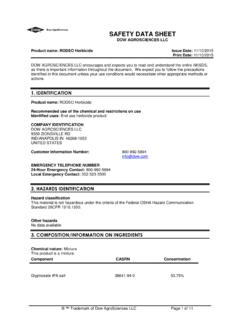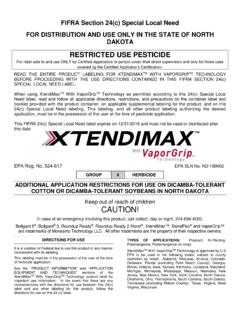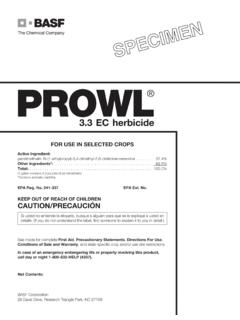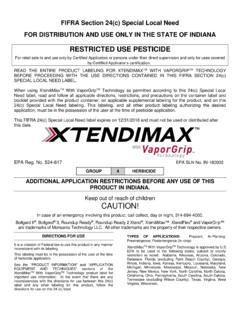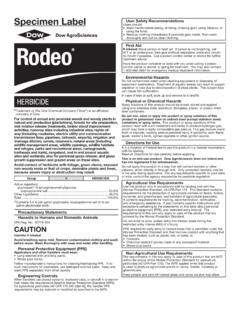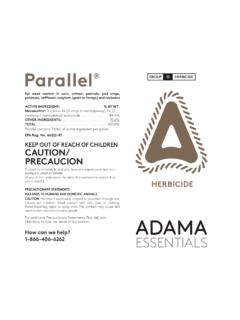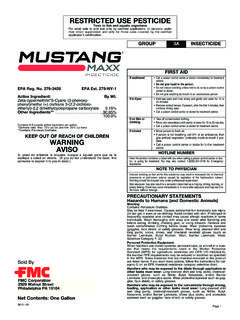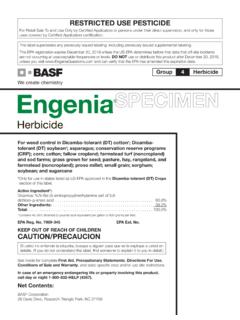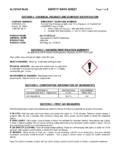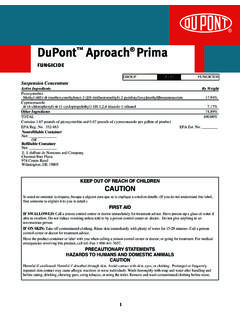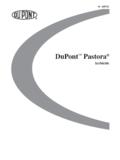Transcription of SPECIMEN LABEL 2,4-D AMINE 4 - CDMS
1 SPECIMEN LABEL . 2,4-D AMINE 4 HERBICIDE. For selective control of many broadcast weeds in certain crops, ACTIVE INGREDIENT: Dimethylamine salt of 2,4-dichlorophenoxyacetic acid* .. including, cereal grains (wheat, barley, millet, oats and rye), OTHER INGREDIENTS: .. corn (field corn, popcorn and sweet corn), fallow land and crop TOTAL:.. stubble, rice, sorghum (grain and forage sorghum), soybeans (preplant burndown application only); forests; rangeland and *Equivalent to of 2,4-dichlorophenoxyacetic acid or Isomer specific by AOAC Method. EPA Reg. No. 42750-19. established grass pastures, including Conservation Reserve Program (CRP) acres; non-cropland; grasses grown for seed or KEEP OUT OF REACH OF CHILDREN sod, ornamental turf; and aquatic areas.
2 DANGER PELIGRO. Si usted no entiende la etiqueta, busque a alguien para que se la explique a usted en detalle. (If you do not understand this LABEL , find someone to explain it to you in detail.) Manufactured By: FIRST AID. IF IN EYES Hold eye open and rinse slowly and gently with water for 15-20 minutes. Albaugh, LLC. Remove contact lenses, if present, after the first 5 minutes, then continue rinsing eye. Call a poison control center or doctor for treatment advice. Ankeny, Iowa 50021. IF SWALLOWED Call a poison control center or doctor immediately for treatment advice. Have person sip a glass of water if able to swallow. Do not induce vomiting unless told to do so by the poison control center or doctor. Do not give anything by mouth to an unconscious person.
3 IF ON SKIN OR Take off contaminated clothing. FOR CHEMICAL SPILL, LEAK, CLOTHING Rinse skin immediately with plenty of water for 15-20 minutes. FIRE, OR EXPOSURE CALL. Call a poison control center or doctor for treatment advice. CHEMTREC (800) 424-9300. IF INHALED Move person to fresh air. If person is not breathing, call 911 or an ambulance, hen give artificial respiration, preferably mouth-to-mouth, if possible. Call a poison control center or doctor for further treatment advice. HOT LINE NUMBER. Have the product container or LABEL with you when calling a poison control center or doctor, or going for treatment. You may also contact 1-800-424-9300 for emergency medical treatment information. NOTE TO PHYSICIAN: Probable mucosal damage may contraindicate the use of gastric lavage.
4 See inside booklet for additional precautionary statements. AD120115. PRECAUTIONARY STATEMENTS. hazards TO HUMANS AND domestic ANIMALS. DANGER. Corrosive. Causes irreversible eye damage. Harmful if swallowed. Do not get in eyes or on clothing. Avoid contact with skin. Prolonged or frequently repeated skin contact may cause allergic reactions in some individuals. PERSONAL PROTECTIVE EQUIPMENT. Some materials that are chemical-resistant to this product are butyl rubber, natural rubber, neoprene or nitrile rubber. All mixers, loaders, applicators, flaggers, and other handlers must wear: 1. Long-sleeved shirt and long pants. 2. Shoes and socks. 3. Chemical resistant gloves when applying with any handheld nozzle or equipment, mixing or loading, cleaning up spills or equipment, or otherwise exposed to the concentrate.
5 4. Chemical resistant apron when, mixing or loading, cleaning up spills or equipment, or otherwise exposed to the concentrate. 5. Wear protective eyewear (goggles or face shield). See engineering controls for additional requirements. Discard clothing and other absorbent materials that have been drenched or heavily contaminated with this product's concentrate. Do not reuse them. Follow manu- facturer's instructions for cleaning/maintaining PPE. If no such instructions for washables exist, use detergent and hot water. Keep and wash PPE separately from other laundry. After each day of use, clothing or PPE must not be reused until it has been cleaned. ENGINEERING CONTROLS STATEMENTS. Pilots must use an enclosed cockpit that meets the requirements listed in the WPS for agricultural pesticides [40 CFR (d)(6)].
6 When handlers use enclosed cabs or aircraft in a manner that meets the requirements listed in the Worker Protection Standard (WPS) for agricultural pesticides [40. CFR (d)(4-6)], the handler PPE requirements may be reduced or modified as specified in the WPS. USER SAFETY RECOMMENDATIONS. Users should: Wash hands before eating, drinking, chewing gum, using tobacco or using the toilet. Remove clothing/PPE immediately if pesticide gets inside. Then wash thoroughly and put on clean clothing. Remove PPE immediately after handling this product. Wash the outside of gloves before removing. As soon as possible, wash thoroughly and change into clean clothing. ENVIRONMENTAL hazards . This pesticide is toxic to fish and aquatic invertebrates. For terrestrial uses: Do not apply directly to water, or to areas where surface water is present, or to intertidal areas below the mean high water mark.
7 Drift and runoff may be hazardous to aquatic organisms in water adjacent to treated areas. Do not contaminate water when disposing of equipment washwaters or rinsate. Apply this product only as directed on LABEL . This chemical has properties and characteristics associated with chemicals detected in groundwater. The use of this chemical in areas where soils are permeable, particularly where the water table is shallow, may result in groundwater contamination. Application around a cistern or well may result in contamination of drinking water or groundwater. Fish breathe dissolved oxygen in the water and decaying weeds also use oxygen. For aquatic uses: when treating continuous, dense weed masses, it may be appro- priate to treat only part of he infestation at a time.
8 For example, apply the product in lanes separated by untreated strips that can be treated after vegetation in treated lanes has disintegrated. During the growing season, weeds decompose in a 2 to 3 week period following treatment. Begin treatment along the shore and proceed outwards in bands to allow fish to move into untreated areas. Waters having limited and less dense weed infestations may not require partial treatments. Mixing and Loading: cases of groundwater contamination involving phenoxy herbicides such as 2,4-D have been associated with mixing/loading and disposal sites. Caution should be exercised when handling 2,4-D pesticides at such sites to prevent contamination of groundwater supplies. Use of closed systems for mixing or transferring this pesticide will reduce the probability of spills.
9 Placement of the mixing/loading equipment on an impervious pad to contain spills will help prevent groundwater contamination. 2. STORAGE AND DISPOSAL. Do not contaminate water, food or feed by storage or disposal. PESTICIDE STORAGE: Open dumping is prohibited. Do not store this product near fertilizers, seeds, insecticides, or fungicides. Reclose all partially used con- tainers by thoroughly tightening screw cap. Absorb any spill with a suitable clay absorbent and dispose of as indicated under Pesticide Disposal.. Protect from freezing. If stored below freezing, the product must be warmed to at least 70 F and agitated before using. This does not affect the efficiency of the product. For safety and prevention of unauthorized use, all pesticides should be stored in locked facilities.
10 To prevent accidental misuse, different pesticides should be stored in separate areas with enough distance between to provide clear identification. Opened, partially used pesticides should be stored in original labeled containers when possible. When transfer to another container is necessary because of leak- age or damage, carefully mark and identify contents of the new container. PESTICIDE DISPOSAL: Pesticide wastes are toxic. Improper disposal of excess pesticide, spray mixture, or rinsate is a violation of federal law and may con- taminate groundwater. If these wastes cannot be disposed of by use according to LABEL instructions, contact your state Pesticide or Environmental Control Agency or the Hazardous Waste Representative at the nearest EPA Regional Office for guidance.
